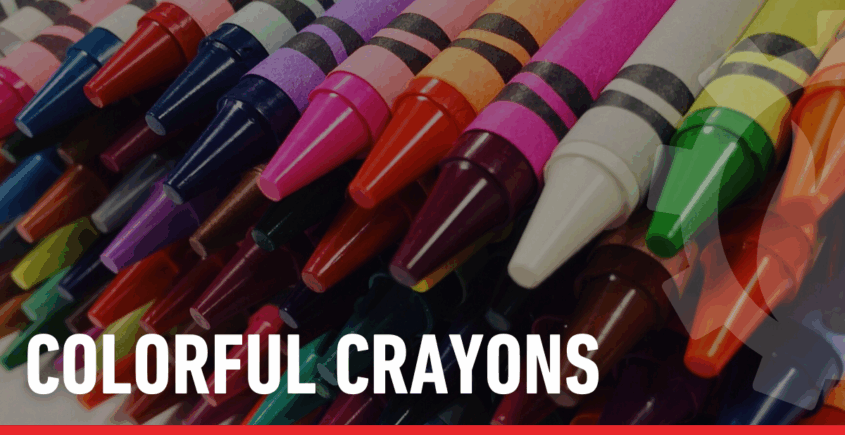Colorful Crayons
Yep, it’s that time of year when the little munchkin’s head off to another exciting school year – some have started already, and some do not go back until after Labor Day. I can remember the excitement I had, seeing old friends, going to a new classroom, finding my seat, and getting to use all of those “new’ back-to-school supplies. One, of course, was a new box of crayons. I’ll bet you can agree – especially the 64 pack with the built-in sharpener!! (never went for the 96 or 120 pack – anyone who has seen my coloring skills would understand!!) There’s something magical about opening a brand-new box of crayons – the waxy scent, the pristine tips, the rainbow of possibility – it’s a small ritual that signals the start of a new school year, full of hope and creativity. I have to admit, using the crayon sharpener was always a bunch of fun, my friends and I would have contests to see who could have the sharpest crayon or biggest pile of shavings (unfortunately for my parents/teachers – the shavings ended up everywhere!) Here’s some fun trivia on crayons in the US, and a cool “how they’re made video. Enjoy, and thanks to Google, Wikipedia, and Smithsonian.com for the info.

The word crayon itself comes from the French word for “chalk,” and while artists have used various wax-and-pigment combinations for centuries, it wasn’t until Crayola’s innovation that crayons became a staple in childhood art supplies. Crayola means “oily chalk.” The name is a mash-up of “craie” (French for chalk) and “ola” (from oleaginous, or oily).
Crayons as we know them today were first mass-produced in the United States by Binney & Smith, the company that would become Crayola, in 1903. They introduced a line of crayons that was safe, affordable, and colorful for children.
Binney & Smith was a small, 21-year-old firm owned by Edwin Binney and C. Harold Smith. They were already in the business of making color. They owned the rights to a line of red oxides of iron for the red paint used by most farmers on their barns. And they were also sellers of lamp black and white chalk. They had been among the first to solve the centuries-old problem of how to manufacture a really black black. The answer was expensive carbon black. Binney & Smith likes to credit itself for figuring out how to make it inexpensively. (At the 1900 Paris Exposition, the company won a gold medal for its carbon black display.)
The original box sold for just a nickel and contained eight colors: red, orange, yellow, green, blue, violet, brown, and black.
Over 3 billion crayons are made each year by Crayola alone (that’s enough to circle the earth nearly six times if laid end to end!)
The average child in the U.S. will wear down about 730 crayons, or in my case, shave down by the time they turn 10.
Boxes come in all sizes to suit classrooms, home use, and art studios:
- Classic 8-pack (great for school basics)
- 24-pack (standard for most classrooms)
- 64-pack (includes sharpener and many fun colors)
- 96-pack and 120-pack (for serious young artists)
- Bulk class packs (each color in large quantities)
Crayola has produced over 400 different crayon colors since its founding, and some color names are legendary—part educational, part whimsical. (I like Fuzzy Wuzzy) Some favorites include:
- Macaroni and Cheese (introduced in 1993)
- Razzmatazz (a deep magenta from 1993)
- Robin’s Egg Blue
- Atomic Tangerine
- Jazzberry Jam
- Outer Space
Some colors have been retired or renamed: “Flesh” was renamed “Peach” in 1962, during the civil rights movement. “Indian Red” became “Chestnut” in 1999 to avoid confusion about Native American references (it actually referred to a pigment from India).
In 2017, Crayola held a national vote to name its new blue color, discovered by accident by scientists—it was dubbed Bluetiful.
The scent of crayons is so iconic that Yankee Candle once made a crayon-scented candle. A Yale University study once ranked the smell of crayons as the 18th most recognizable scent to American adults.
Fun Trivia – In June 1990, Binney & Smith decided to retire eight of its old colors to make some of the more modern, brighter colors that children seemed to be searching for in their artistic palettes. Not so fast, said a few of Crayola’s veteran fans. One morning, a few weeks later, Binney & Smith executives arrived at their headquarters to find picketers protesting the decision. The RUMPs, or Raw Umber and Maise Preservation Society, and the CRAYONs, or Committee to Reestablish All Your Old Norms, had quickly mobilized their constituents. When the old colors were re-released later that year in a special holiday commemorative collection, the groups were mollified.
How did you do on last week’s logo contest?
Check out our logo guide for the “Wedding Rice & Rituals” post here!






Leave a Reply
Want to join the discussion?Feel free to contribute!